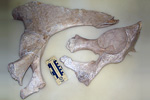

The Quaternary in Southeast region, Mexico |
|||||||||||||||||||||||||||||||||||||||||||||||||||||||||||
|
|||||||||||||||||||||||||||||||||||||||||||||||||||||||||||
Paleontology and geologyVolcanic activity continued into the Quaternary in the south and west, and some volcanoes are still active today. Pine forests grew at higher elevations, while tropical forests and grasslands covered the rest of the region. Fresh water continued to dissolve limestones in the Yucatan Peninsula, expanding older caves and forming new ones and cenotes. The tropical climate and abundant vegetation of the Southeastern Region make the preservation and discovery of fossils difficult. A few caves and other sites have produced fossils of animals from North and South America, including mammoths, deer, bison, shrews, opossums, frogs, lizards, and birds. Along the coasts, particularly in the east and on some of the islands, some marine deposits that formed during times of higher sea levels contain fossilized coral reefs. |
|||||||||||||||||||||||||||||||||||||||||||||||||||||||||||
|
|
|||||||||||||||||||||||||||||||||||||||||||||||||||||||||||
|
site tour |
about the site |
site map |
site credits |
page credits |
help |
FAQs |
contact |
||



